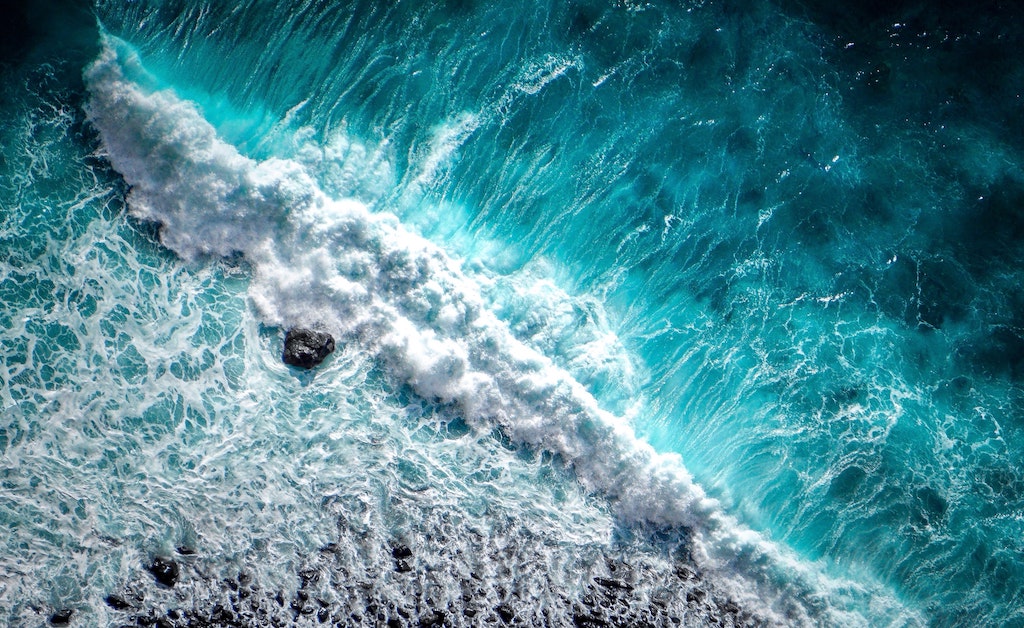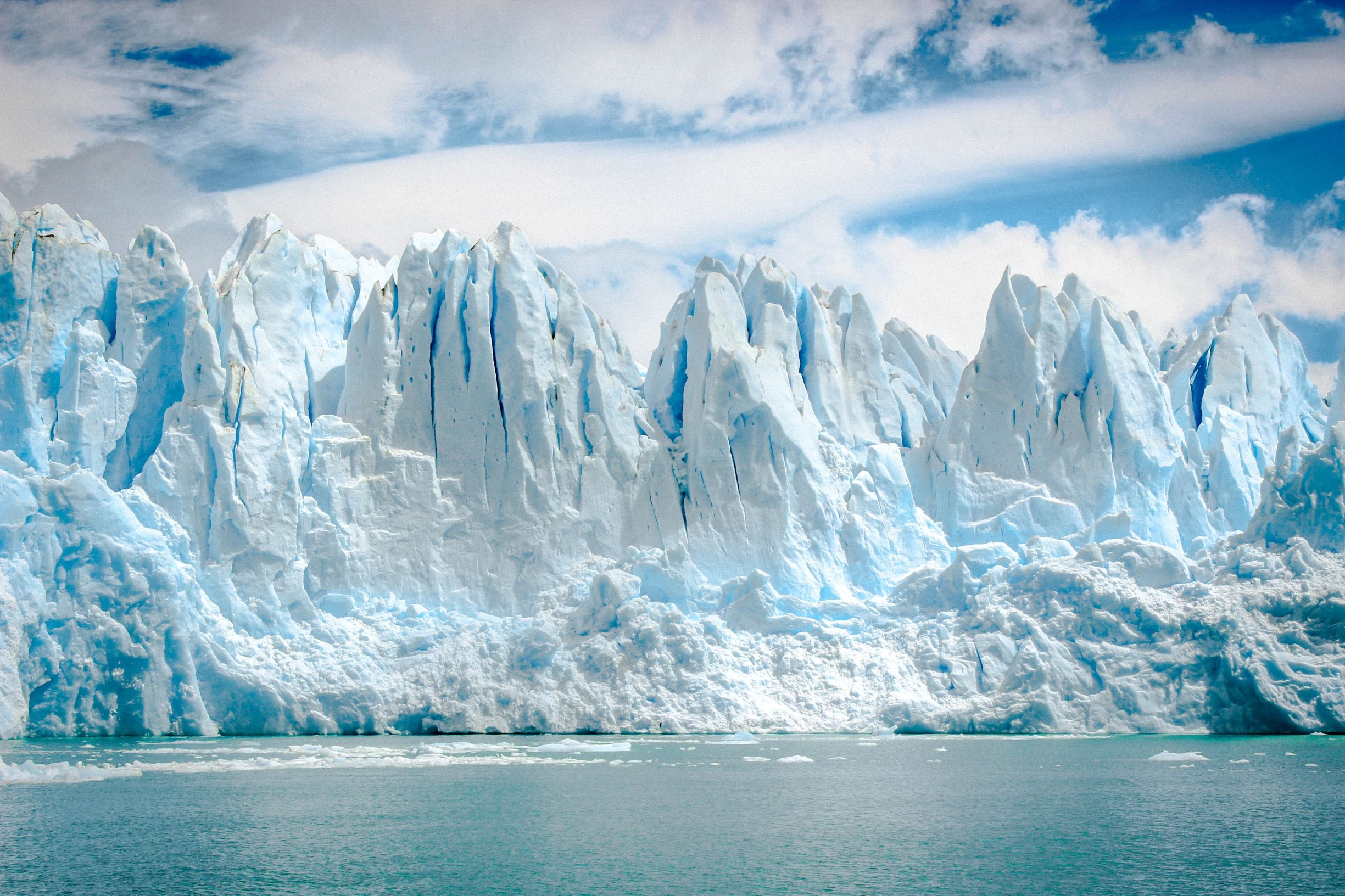Written by: Riley Palmer
The cold permeates every aspect of your being and you pull your coat tighter around your shoulders as the biting wind threatens to blow away any remaining remnants of warmth. Snow crunches softly under your feet as you walk to higher ground to better see the awesome view beneath you. A mountainous river of ice flows below you in static motion. Light reflects off the pale blue crevices and ridges blinding you and making your entire world a wash of monochromatic brilliance. You forget the cold for a moment as you stare across one of the last monuments of the ice age, an awesome testament to the power and timelessness of nature. Unfortunately, such views are becoming more and more scarce as warming temperatures threaten the existence of glaciers around the world.
Glacier Formation
Glaciers are formed by accumulation of snow in mountainous regions. As snow accrues, it becomes compressed, transforming snow into ice. Over time, layer upon layer of ice begins to amass increasing the glacier’s size and weight. When enough layers of ice form, the collective weight causes them to compress into one large ice mass. The weight of the glacier is so extreme that it forces the glacier to move. As the glacier starts to slowly slide down the mountain, the amount of pressure exerted begins to melt the bottom layer of ice, which creates a slippery surface for the glacier to move over. Glacial forces are so intense that huge swaths of earth are eroded, and trenches and ravines are carved out of the landscape. When glaciers retreat, these depressions form lakes which provide freshwater to rivers and streams.
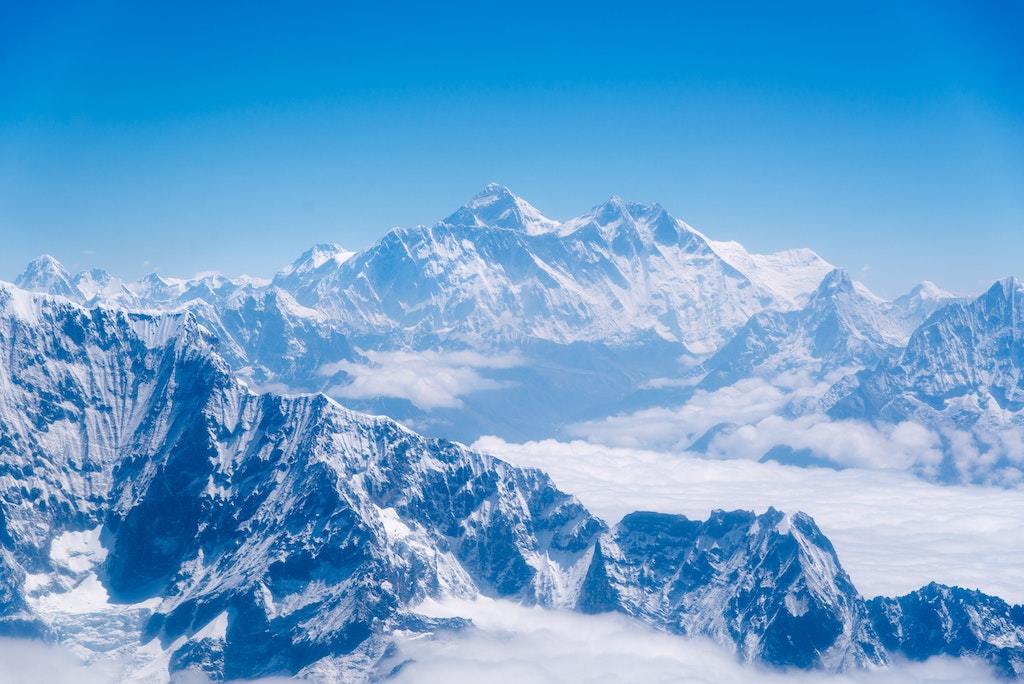
Mount Everest – the tallest mountain in the world. Photo by Andreas Gäbler on Unsplash
During the last ice age, glaciers covered the surface of the earth in large expanses of ice. At the start of the interglacial period, temperatures began to warm, causing glacial retreat. Today, glaciers can be found in very cold and mountainous regions all over the world, including the Himalayas. This magnificent mountain range in Southeast Asia winds through China, India, Pakistan, Bhutan, and Nepal and separates the Tibetan Plateau from the plains and lowlands of India. The Himalayas are famous for having the tallest mountain in the world: Mount Everest. While we may be familiar with stories of adventurers braving the summit of Mount Everest, we may hear less about the 52.7 million people who call the Himalayas home or the 450 million who live at the base of the mountain range. Most people living on the Himalayan mountains survive on subsistence hunting and farming of crops such as rice, wheat, millet, and soy. Irrigation for these crops comes from snow and glacial melt. Himalayan cultures depend directly on the mountains as a source of food and water.
Glaciers have natural cycles of accumulation and melting. In warm, summer months, the parts of the glacier lower down the mountain begin to melt, providing an important source of freshwater to plants, animals, and humans. In the cold, winter months, snowfall in the mountains supplies the glacier with the water mass lost due to melting in warmer months. In a healthy environment, the amount of snow accumulation matches or surpasses the amount of snow melt, either increasing the glacier’s mass or keeping it constant. However, due to human activities and climate change, glaciers are melting faster than ever before, creating serious issues such as flooding in the short term and water scarcity in the future.
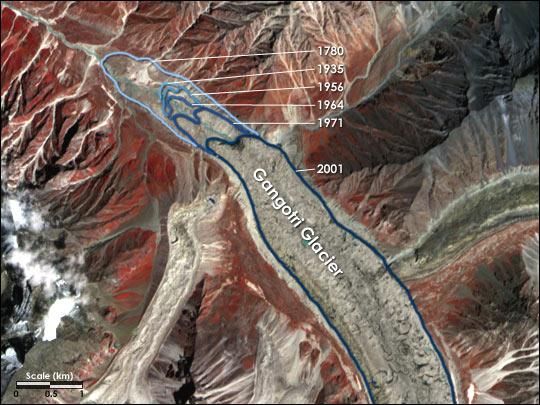
The Gangotri Glacier is one of the largest glaciers in the Himalayas. It has been receding since the 1780s. The blue lines show how the glacier has changed and diminished in mass over time. Courtesy of NSIDC, 2020
Short Term Effects of Glacier Melt
In the short-term, as temperatures increase, more and more of the glacier will melt, causing riverbanks to overflow, killing people, and causing destruction to crops and property.
Many glaciers end in lakes that are naturally dammed, either by moraines or ice. Moraines are formed by glacial retreat. Glaciers are incredibly powerful and are capable of picking up large boulders and depositing them thousands of miles from their origin. During the last ice age, glacier extant was much further than it is today. When temperatures began to warm and glaciers began to retreat, all the debris that the glaciers had picked up during their expansion were left behind forming large masses of rubble. These large deposits of stones and boulders are termed moraines. With warming temperatures and increased ice melt, moraines and ice dams are suddenly put under vast amounts of water pressure and will burst, causing catastrophic flooding downstream of the lake. With climate change, the threat of glacial flooding is much higher than in previous decades and has the potential to kill thousands of people, destroy infrastructure, and slow the progress of hydroelectric energy development.
In addition to flooding, glaciers can cause landslides. As glaciers warm and melt, large chunks of ice can break off the glacier. The force of the falling ice causes it to collect debris, increasing the force of the landslide. Often, these landslides have the potential to break dams, which then causes flooding in addition to a landslide. Unfortunately, an instance of this occurred recently in India. The flooding left dozens of people dead, over 100 missing, and destroyed two hydroelectric power-plants. Such events are expected to become more common as glacier melt increases in the 21st century.
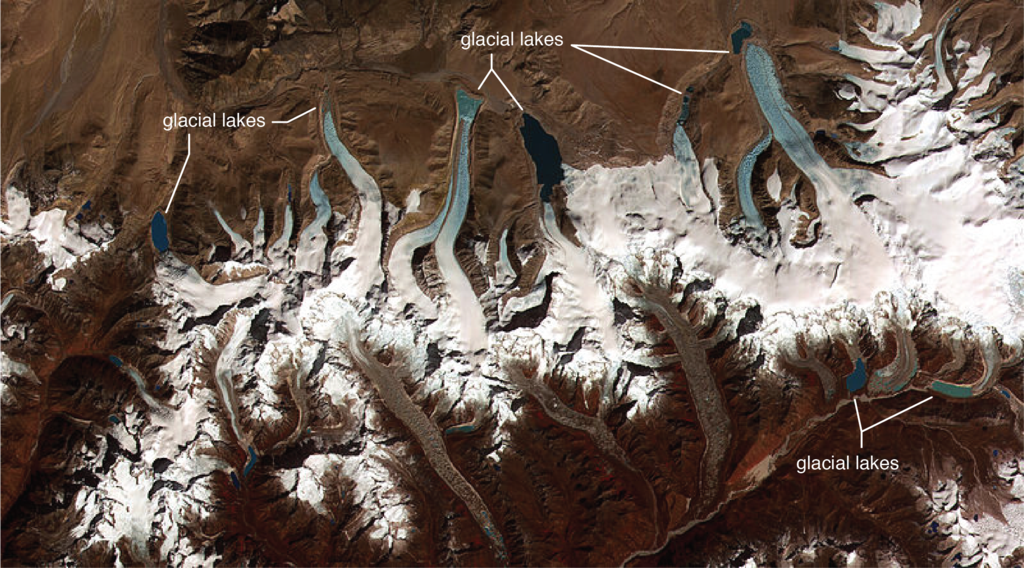
Lakes often form at the end of glaciers. While the lakes are usually maintained by natural dams, they sometimes break through the dam creating catastrophic flooding. Pictured are lakes formed by glacial retreat in Bhutan. Courtesy of Bendle, 2020
Long Term Effects of Glacier Melt
Glacier melt is a common part of the glacier lifecycle, however, so is the re-accumulation of glacial ice through snowfall. With increasing temperatures, snowfall will become less frequent, and the amount of water lost through melting will not be redeposited on the glacier. This means that while glacial melt in the short-term causes flooding, in the long-term it equals water scarcity. If the amount of water lost is not being replaced, the glacier will melt away to nothing and the rivers that depend on glacial melt as a water source will dwindle and potentially disappear. This poses threats to many communities around the world that depend on glacial melt as a freshwater source, and this threat is particularly great in Asia, where a huge proportion of people live near and depend on glacial rivers for water.
Glacier Melt in Asia
While glacier melt is a global concern, anxieties are particularly high for the consequences in Asia. The Himalayas are considered the “water tower” of Asia, with glaciers providing freshwater to China, India, Bhutan, Bangladesh, Nepal, Pakistan, and Afghanistan. Glacier melt is particularly important for the Ganges and Indus river basins. Much of the freshwater that feeds these rivers comes from glaciers in the Himalayas and, as the mass of these glaciers decrease, the people and ecosystems dependent on these river basins will face a myriad of issues.
The Ganges flows through parts of India, Nepal, Bangladesh, and China and terminates in the Bay of Bengal. It is estimated that as much as 40% of the Ganges is fed by glacier melt and 60% of the river is used for crop irrigation. The Ganges runs through some of the most populated areas on earth, and a 40% reduction in water caused by the loss of glaciers would not only threaten the water supply of inhabitants dependent on the Ganges for freshwater, but would also negatively impact crop production, causing food scarcity. With climate change, precipitation patterns around the world are becoming more variable. Historically, the Ganges received a large percentage of its water from the rains during the monsoon season. However, while monsoons are becoming more intense, they are becoming less frequent and there has been an increasing number of droughts. During drought years, glaciers are still able to provide freshwater through ice melt. As glaciers melt away to nothing, drought years will become even drier, which will prevent crop irrigation and cause food and water shortages to be even more extreme.
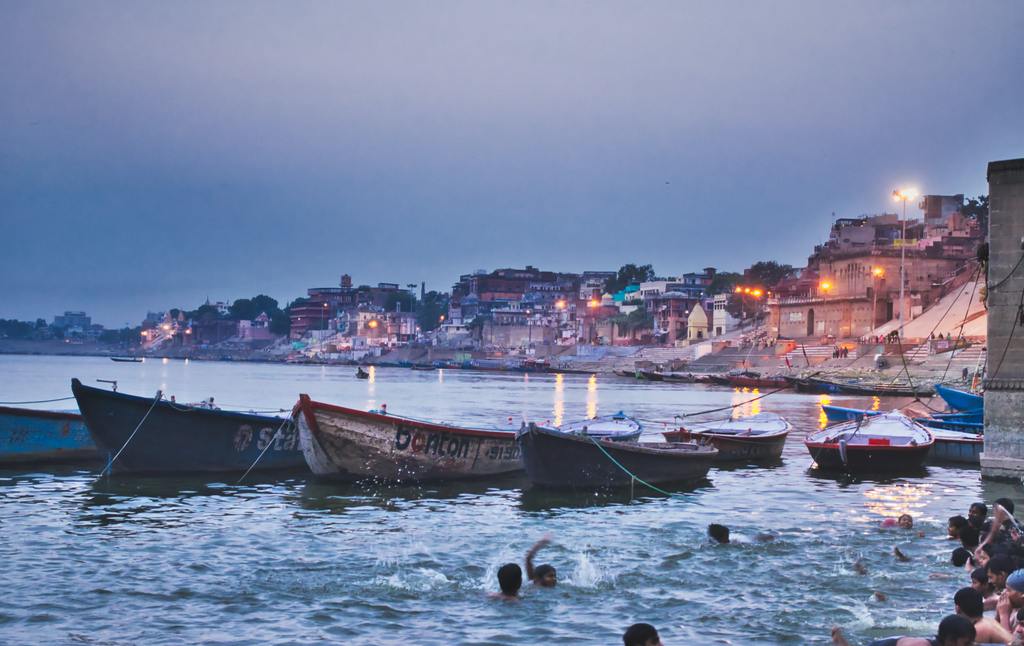
The Ganges River in Varanasi, Uttar Pradesh, India. Photo by Shiv Prasad on Unsplash
The Indus flows through India, China, Afghanistan and Pakistan. The Indus river output is the Arabian Sea and provides important freshwater habitats for different types of fauna and mangroves – incredibly productive ecosystems that provide coastal protection and water filtration. The Indus river basin is much more arid than the Ganges and therefore receives less freshwater input from precipitation. As much as 70% of the Indus is fed by glaciers and since there is less rainfall, nearly 80% of the Indus is used for crop irrigation. Since the Indus has so much freshwater input from glaciers, it is highly susceptible to climate change. The increasing temperatures will cause higher variability in river flow, less predictability, flooding and eventually water shortages. In fact, water shortages are already beginning to occur in the Indus valley, especially in Pakistan, which is by far the most arid country dependent on the Indus. Water is already having to be shipped in from hundreds of miles away to feed irrigation canals and provide drinking water to residents. As river flow diminishes in the second half of the 21st century due to a loss of glacier melt, water shortages will be exacerbated causing a loss of crops and forcing people to move to places with more freshwater availability.
Conclusion
One of the significant, negative impacts of climate change is the melting of glaciers around the globe. Glaciers are an important source of freshwater for many people, and increasing temperatures are causing glaciers to melt at unprecedented rates. The increase in input to rivers and glacial lakes will initially cause flooding, destroying crops, property, and infrastructure. However, at some point, glaciers will be so reduced they will stop providing enough freshwater to sustain important rivers, especially rivers like the Ganges and Indus that support a huge proportion of the world’s population. Water shortages in these regions will not only cause scarcity of drinking water, but also prevent irrigation of crops, causing food shortages and depriving farmers of income. In order to protect the livelihoods and well-being of people dependent on glaciers as a source of freshwater, we not only need to start mitigating climate change, but also enact policies to provide flood management planning, drought relief programs, and better storage and management of freshwater resources.
References
Albinia, A. (2021, February 10). A water Crisis looms for 270 million people as South Asia’s GLACIERS SHRINK. Retrieved March 14, 2021.
Armstrong, R.L., Rittger, K., Brodzik, M.J. et al. Runoff from glacier ice and seasonal snow in High Asia: separating melt water sources in river flow. Reg Environ Change 19, 1249– 1261 (2019). https://doi-org.access.library.miami.edu/10.1007/s10113-018-1429-0
Bendle, J. (2020, August 27). Glacial Lake Outburst Floods. Retrieved March 14, 2021, from http://www.antarcticglaciers.org/glacier-processes/glacial-lakes/glacial-lake-outburst-floods/.
IPCC. (2014). FAQ 2.1: How does GLACIER shrinkage Affect river RUNOFF FURTHER DOWNHILL? Retrieved March 14, 2021, from https://www.ipcc.ch/srocc/about/faq/faq-chapter-2/#:~:text=Glaciers%20supply%20water%20that%20supports,and%20changes%20the%20water%20availability
Jacobo, J. (2021, February 16). Deadly glacier break: Himalayan glaciers will collapse more frequently as climate warms, experts say. Retrieved March 14, 2021, from https://abcnews.go.com/International/deadly-glacier-break-himalayan-glaciers-collapse-frequently-climate/story?id=75810404
Malone, E. (2010, November). CHANGING GLACIERS AND HYDROLOGY IN ASIA ADDRESSING VULNERABILITIES TO GLACIER MELT IMPACTS. Retrieved March 2021, from http://www.ehproject.org/PDF/ehkm/usaid-glacier_melt2010.pdf
National Geographic Society. (2012, October 09). Glacier. Retrieved March 14, 2021.
NSIDC. (2020, March 16). National snow and Ice data center. Retrieved March 14, 2021, from https://nsidc.org/cryosphere/glaciers/questions/climate.html
Sharma, B., & Sharma, D. (2008, January). Impact of Climate Change on Water Resources and Glacier Melt and Potential Adaptations for Indian Agriculture. Retrieved March, 2021.
Watanabe, T., Lamsal, D., & Ives, J. (2009). Evaluating the growth characteristics of a glacial lake and its degree of danger of outburst flooding: Imja Glacier, Khumbu Himal, Nepal, Norsk Geografisk Tidsskrift – Norwegian Journal of Geography, 63:4, 255-267, DOI: 10.1080/00291950903368367


